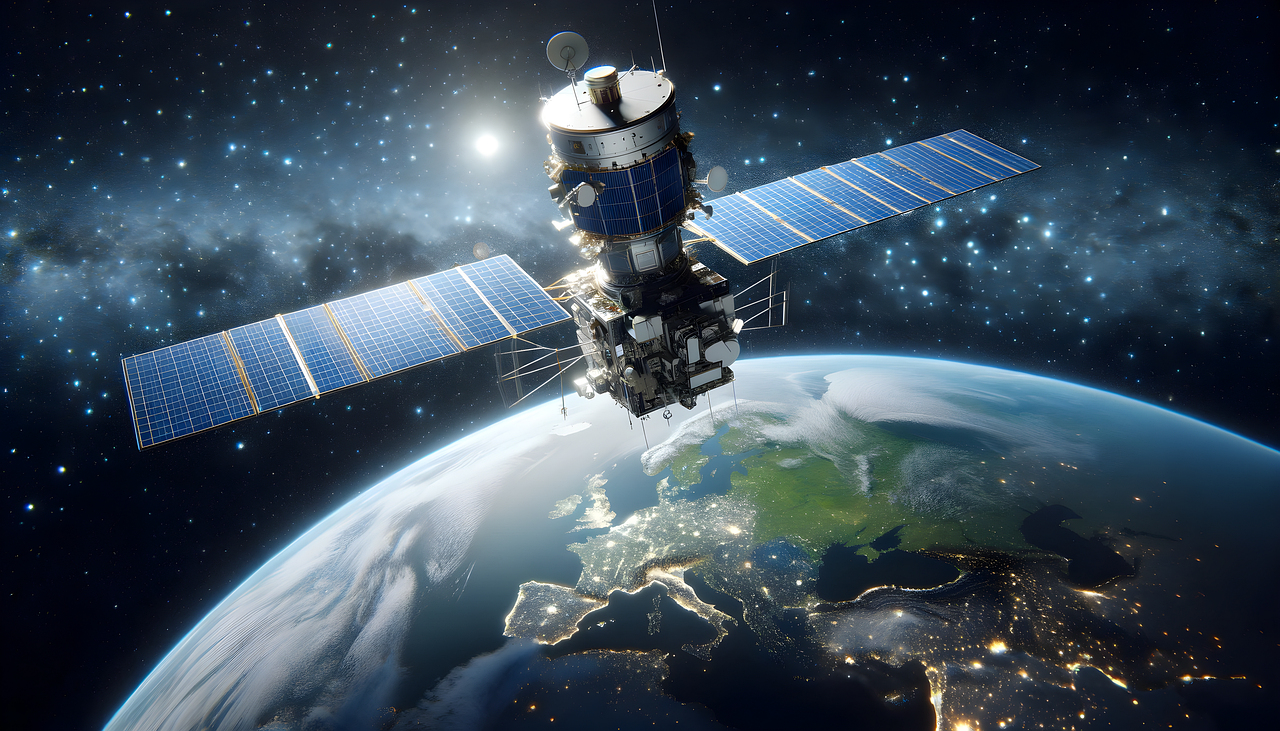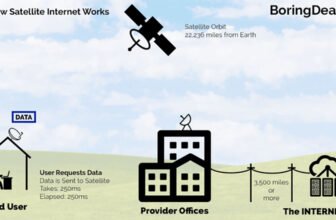
What is Satellite Internet, Uses And Function?
Satellite internet is a type of broadband connection that provides internet access through communication satellites. Unlike traditional internet options such as DSL, cable, or fiber-optic networks, satellite internet does not rely on underground cables or physical infrastructure near the user’s location. Instead, it uses satellites orbiting the Earth to deliver internet connectivity, making it an ideal solution for remote and underserved areas.
The technology involves three primary components:
- Satellite: Positioned in geostationary or low Earth orbit (LEO), these satellites transmit and receive signals.
- Ground Stations: Located on Earth, these facilities send and receive data to and from the satellite.
- User Equipment: This includes a satellite dish and modem installed at the user’s location to communicate with the satellite.
How Does Satellite Internet Work?
Satellite internet works by using radio waves to communicate between a satellite in orbit and a dish installed at the user’s location. When a user accesses the internet, their request is sent to the satellite via the dish. The satellite then relays the request to a ground station, which connects to the broader internet. The response data follows the reverse path, traveling from the ground station to the satellite and then back to the user’s dish.
This round-trip communication enables users to browse websites, stream videos, and perform other online tasks. However, the distance between the Earth and the satellite can introduce latency, which affects real-time activities like gaming or video conferencing.
Uses of Satellite Internet
Satellite internet has diverse applications, serving both individual and institutional needs. Key uses include:
- Rural and Remote Connectivity: For areas without access to cable or fiber infrastructure, satellite internet provides a viable alternative. It bridges the digital divide by bringing internet access to remote villages, farms, and isolated communities.
- Disaster Recovery: During natural disasters, terrestrial internet infrastructure often gets damaged. Satellite internet can quickly restore connectivity for emergency responders and affected populations.
- Maritime and Aviation Industries: Ships and airplanes rely on satellite internet to provide onboard Wi-Fi, enhance navigation systems, and enable real-time communication.
- Military and Government Use: Satellite internet supports secure communications, reconnaissance, and strategic operations in remote areas.
- Business Continuity: Companies use satellite internet as a backup solution to maintain operations during terrestrial network outages.
- Educational and Healthcare Outreach: In regions with limited resources, satellite internet enables online learning, telemedicine, and remote consultations.
Advantages of Satellite Internet
Satellite internet offers several benefits that make it a valuable option for specific scenarios:
- Wide Coverage: Satellites can provide internet access almost anywhere on Earth, from remote deserts to polar regions.
- Infrastructure Independence: It does not rely on local infrastructure, making it ideal for areas lacking fiber-optic or cable networks.
- Quick Deployment: Installing a satellite dish and modem is faster than building terrestrial networks, especially in hard-to-reach locations.
- Resilience: Satellite internet can continue to function during natural disasters that disrupt terrestrial networks.
Challenges of Satellite Internet
Despite its advantages, satellite internet has limitations:
- Latency: The time it takes for signals to travel between the user, satellite, and ground station can result in noticeable delays.
- Weather Sensitivity: Heavy rain, snow, or storms can interfere with signal quality, leading to slower speeds or interruptions.
- Data Caps: Many satellite internet plans impose data usage limits, restricting high-bandwidth activities.
- Cost: Equipment installation and monthly plans can be more expensive compared to other internet options.
Comparison with Other Internet Options
When compared to DSL, cable, fiber, and mobile broadband, satellite internet stands out for its coverage but falls short in speed and latency:
- DSL and Cable: These technologies offer lower latency and higher speeds at a lower cost but are limited by infrastructure availability.
- Fiber-Optic: Fiber provides unmatched speed and reliability but requires extensive physical infrastructure, making it inaccessible in remote areas.
- Mobile Broadband: While mobile networks are faster and more portable, they depend on cell tower proximity and cannot reach extremely remote areas like satellite internet can.
Everyday Applications of Satellite Internet
Satellite internet has become increasingly useful in daily life, especially for individuals and businesses in areas without reliable terrestrial connections. Examples include:
- Remote Work: Professionals can work from virtually anywhere, accessing cloud services, video conferencing, and collaboration tools.
- Streaming and Entertainment: Satellite internet supports video streaming, online gaming, and social media use, albeit with potential latency issues.
- Smart Agriculture: Farmers use satellite internet to monitor crops, control irrigation systems, and access weather forecasts.
- Online Education: Students in remote areas can attend virtual classes, access online resources, and participate in global learning opportunities.
- Telemedicine: Patients in underserved regions can consult with doctors and access medical services through video calls.
- Travel and Adventure: Travelers and outdoor enthusiasts use satellite internet for navigation, communication, and sharing experiences.
The Future of Satellite Internet
With advancements in satellite technology, the future of satellite internet looks promising. Low Earth Orbit (LEO) constellations, such as Starlink by SpaceX and OneWeb, aim to reduce latency and increase speeds by positioning satellites closer to Earth. These systems also promise to handle higher data volumes and provide affordable options for users worldwide.
As global internet demand grows, satellite internet is poised to play a crucial role in achieving universal connectivity. It will complement terrestrial networks and ensure that no one is left behind in the digital age.
Conclusion
Satellite internet is a transformative technology that extends connectivity to the farthest corners of the Earth. Its ability to overcome geographical barriers makes it invaluable for rural populations, businesses, and disaster recovery efforts. While it faces challenges like latency and cost, ongoing innovations are addressing these issues and enhancing its capabilities. In an increasingly interconnected world, satellite internet is not just a luxury but a necessity for bridging the digital divide and empowering communities. image/pixabay





